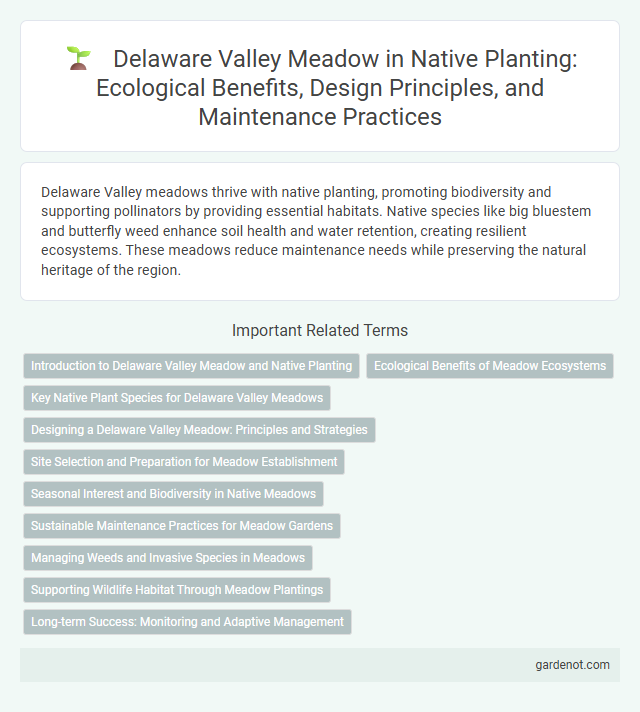Delaware Valley meadows thrive with native planting, promoting biodiversity and supporting pollinators by providing essential habitats. Native species like big bluestem and butterfly weed enhance soil health and water retention, creating resilient ecosystems. These meadows reduce maintenance needs while preserving the natural heritage of the region.
Introduction to Delaware Valley Meadow and Native Planting
The Delaware Valley Meadow showcases a vibrant ecosystem rich in native plant species such as purple coneflower, switchgrass, and New England aster, which contribute to local biodiversity and habitat restoration. Native planting in this region supports pollinators, improves soil health, and reduces the need for irrigation by utilizing plants adapted to the local climate and soil conditions. Efforts to restore and maintain Delaware Valley Meadows emphasize sustainable landscaping practices that foster ecological balance and resilience against invasive species.
Ecological Benefits of Meadow Ecosystems
Delaware Valley meadows provide critical habitat for pollinators, birds, and small mammals, supporting biodiversity and enhancing ecosystem resilience. Their native plant species improve soil health by reducing erosion and increasing nutrient cycling. These meadows also contribute to carbon sequestration and help regulate local hydrology by absorbing and filtering stormwater runoff.
Key Native Plant Species for Delaware Valley Meadows
Key native plant species for Delaware Valley meadows include Little Bluestem (Schizachyrium scoparium), Purple Coneflower (Echinacea purpurea), and Switchgrass (Panicum virgatum). These species provide essential habitat for pollinators like monarch butterflies and native bees while supporting soil health and biodiversity. Incorporating Eastern Blazing Star (Liatris scariosa) and Black-eyed Susan (Rudbeckia hirta) enhances meadow resilience and seasonal color variation.
Designing a Delaware Valley Meadow: Principles and Strategies
Designing a Delaware Valley meadow involves selecting native plant species such as little bluestem, New England asters, and butterfly milkweed to support local pollinators and promote biodiversity. Soil preparation with minimal disturbance preserves native seed banks, while incorporating varying topography creates microhabitats for diverse wildlife. Seasonal planting schedules aligned with regional climate patterns ensure optimal establishment and long-term meadow resilience.
Site Selection and Preparation for Meadow Establishment
Selecting a site for Delaware Valley meadow establishment requires well-drained soil with full to partial sunlight exposure, ideally on a gently sloping terrain to prevent waterlogging. Preparing the soil involves removing existing vegetation through methods like herbicide application or mechanical tilling, followed by soil testing and amendment to adjust pH and nutrient levels. Proper site preparation ensures optimal seed-to-soil contact, critical for the successful germination and growth of native meadow species.
Seasonal Interest and Biodiversity in Native Meadows
Delaware Valley meadows showcase vibrant seasonal interest through a diverse array of native wildflowers and grasses that bloom from spring to fall, providing continuous color and texture. These native meadows support high biodiversity by offering essential habitats for pollinators, birds, and small mammals that thrive in this ecosystem. The integration of native plants enhances soil health and resilience, promoting ecological balance and sustainability year-round.
Sustainable Maintenance Practices for Meadow Gardens
Sustainable maintenance practices for Delaware Valley meadow gardens emphasize minimal mowing to promote native biodiversity and soil health. Incorporating timed burns or selective cutting supports native plant regeneration while controlling invasive species. Applying organic mulches and avoiding synthetic fertilizers maintains the ecological balance essential for long-term meadow vitality.
Managing Weeds and Invasive Species in Meadows
Effective management of weeds and invasive species in Delaware Valley meadows is crucial for preserving native plant diversity and ecosystem health. Regular monitoring combined with targeted manual removal and selective herbicide application minimizes competition from aggressive species like multiflora rose and Japanese stiltgrass. Promoting native grasses and wildflowers through adaptive mowing regimes supports resilience against invasive encroachment and enhances habitat quality.
Supporting Wildlife Habitat Through Meadow Plantings
Delaware Valley meadows provide critical habitat for pollinators such as bees, butterflies, and native birds, enhancing biodiversity in the region. Native meadow plantings supply essential nectar sources and nesting sites, promoting the survival of various insect and avian species. Integrating diverse native grasses and wildflowers supports ecological balance and increases resilience against invasive species.
Long-term Success: Monitoring and Adaptive Management
Long-term success in Delaware Valley meadow restoration relies heavily on continuous monitoring to assess plant health, species diversity, and invasive species presence. Adaptive management strategies enable responsive adjustments to planting techniques and maintenance schedules based on real-time ecological data. Sustained observation ensures resilient native plant communities and enhances ecosystem services such as pollinator support and soil stabilization.
Delaware Valley meadow Infographic

 gardenot.com
gardenot.com